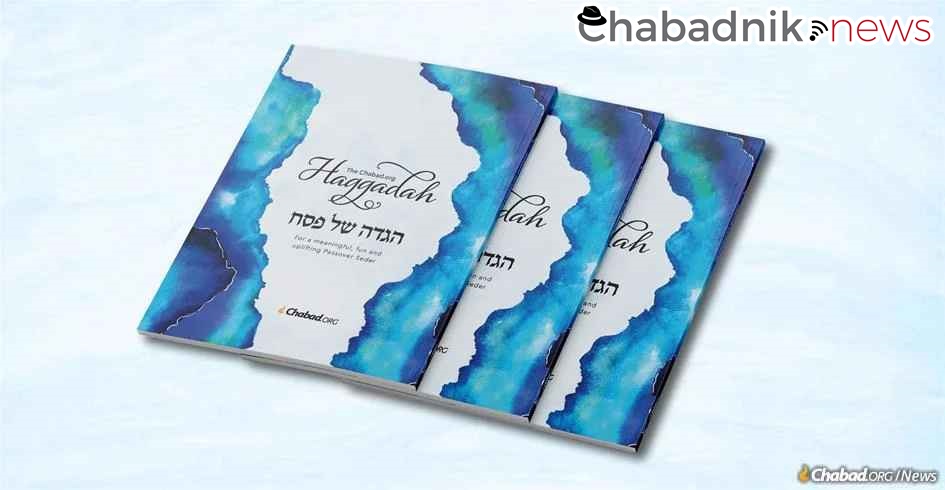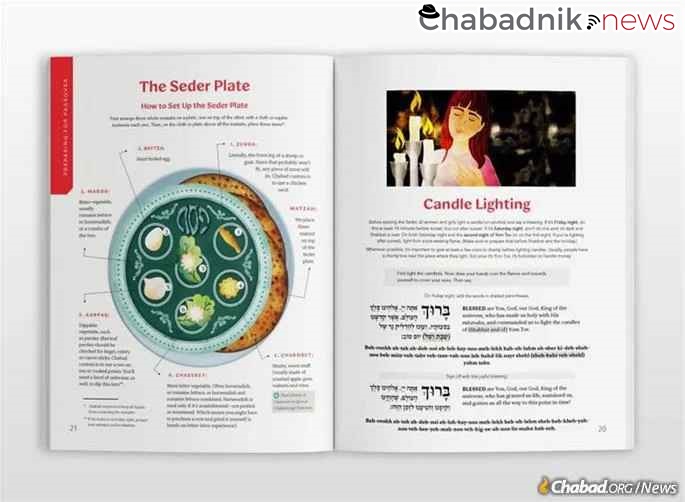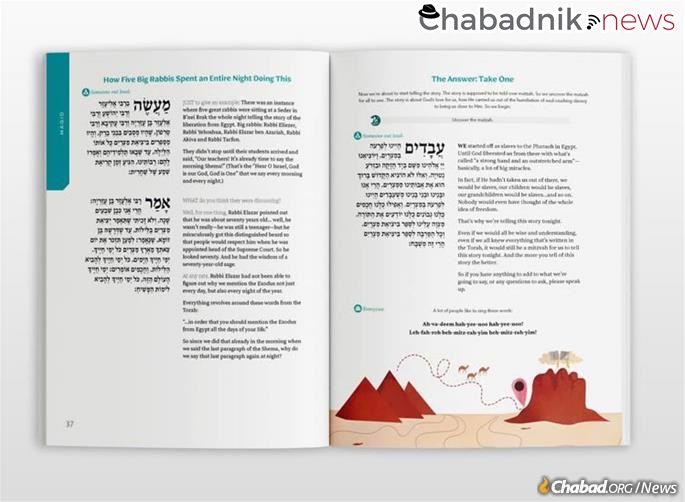Second edition tops Amazon’s charts for both “Haggadahs” and “Jewish holidays” categories

In Spring of 2021, just weeks before what would be many people’s second Passover in isolation, Chabad.org released an all-new Haggadah. The Haggadah came at just the right time for so many who would lead their own Seder for the first time, or were looking for that extra hopeful note in a bleak time. Replete with a user-friendly English translation, original artwork, and timeless insights from The Rebbe, Rabbi Menachem M. Schneerson, of righteous memory, thousands of Haggadahs were ordered from Amazon, and thousands more were downloaded as a free PDF from Chabad.org, in all hundreds of thousands used the Haggadah.
The feedback started pouring in right after the holiday. Most people wanted to express how much they enjoyed the inspiring teachings, pleasing aesthetics, eminently understandable translation, and the handy instructions.
“This is the first time that I didn’t struggle through the Seder,” wrote Laura Wiener, on her 5-star Amazon review. “It’s clear and filled with useful guides and tips. The size is perfect too. Thank you for taking the monotony out of the Seder.”
But there was also constructive criticism—all of which the Chabad.org team took seriously.
For the next six months, the layout was reworked (including many new pieces of custom-commissioned artwork), the instructions were enhanced and sources were added. In addition, many new features were included. Shalom Aleichem and Eishes Chayil were added to the Friday night kiddush service (the first Seder is Friday night this year). The Shabbat daytime kiddush is included as well. Quick-action icons smoothly guide the reader along, and more explanations, guidance and talking points were included to add even more depth to the Seder experience.
The result is a stellar new Haggadah, which has already climbed to the top of Amazon’s charts in 2022 for both “Haggadahs” and “Jewish holidays” categories.
According to a survey sent out to thousands who downloaded the Haggadah for Passover 2021, the most appreciated element of the Haggadah was the clearly labeled and explained instructions. That galvanized the team, led by Rabbi Tzvi Freeman, to further refine, expand, and clarify the instructions in the 2022 edition.
“We completely redesigned the Haggadah. There isn’t a page that has not been carefully examined and improved,” remarked Rabbi Meir Simcha Kogan, Chabad.org’s director, who served as the project’s executive editor. “We were focused on further upgrading the ease of use, comprehension of the age-old liturgy, adding to the depth through insightful teachings all while ensuring that the reader gets an authentic and clear understanding of the flow and progression of the Seder as set forth by the Haggadah.”
And it came through. “As a designer, I know how much detail matters,” says Daniel Rakhamimov, a product designer at Snapchat. “The Haggadah shows the care and love that went into the experience and it’s clear how much went into this Haggadah from the beautiful illustrations to the little gems of commentary that would otherwise get lost in translation.”

A Modern Conundrum
The Haggadah itself was the product of years of work by Chabad.org staff, which was tasked with rethinking how the Seder experience could be made easier to follow and more relevant for a new era. That was a daunting undertaking by any account.
“Creating a Haggadah that speaks to all Jews and every Seder has truly been a team effort,” said Rabbi Kogan. “The editors, designers, and technical teams all played an important part in creating a seamless experience that brings an exciting new Haggadah to you for the Seder.”
The Chabad.org Haggadah was compiled by senior writer Rabbi Tzvi Freeman, award-winning author of Wisdom to Heal the Earth, who has long blazed a path of presenting Jewish mystical concepts in clear and contemporary English prose.
The text of the Haggadah is perhaps the most familiar work of Jewish liturgy in the world. Yet making the text, written in classic Hebrew and Aramaic, accessible has long been a challenge in every era.
“The act of translating the Haggadah in a way that speaks to the modern Jew is a unique conundrum.” says Freeman. Many Haggadahs, looking to make the vast corpus of Jewish wisdom accessible to a modern audience, must choose between two seemingly disparate worlds. “Plenty of wonderful commentaries have appeared in English, drawing from early Talmudic masters to current-day Jewish thinkers, and people enjoy sharing nuggets from those,” says Freeman. “Plenty of rewrites have also appeared,” adapting the text to suit one need or another, “but those lose the sense of continuity-over-epochs that we come to the Seder to experience.”
The Haggadah—rich in Biblical prose, Talmudic-style exegesis and multi-layered rabbinic dialogue—proves difficult to translate. For centuries, when a Jew well versed in the Talmud would open the Haggadah, the text would reveal oceans of meaning. The structure, flow, purpose and place of each section was clear. The characters, sages whose words had been studied all year were instantly recognizable. The reader perceived nuances in their words, allusions in every detail.
But to many today, especially those leading a Seder for the first time in small groups or on their own because of the pandemic, these worlds of meaning are often imperceptible.
From a Seder participant’s standpoint, a translation with commentary doesn’t provide the intended experience in any shape or form for today’s Jew, notes Freeman. The traditional layout of commentary forces the reader’s eyes to the margins, disengaging them from the text.
How then can the timeless wisdom speak to a new audience in a way that brings the past into conversation with the present?
The solution to this challenge lies in the most ancient of Talmudic arts.

Ancient Methodology
The solution, marrying commentary and text, timeless tradition and cutting-edge modernity, is found in a classic solution: Targum.
The classic targumim, the ancient Aramaic renditions of Biblical texts, don’t simply translate the words. They provide context, fill in details, explicate hidden meanings—in other words, they attempt to improve on the original by bringing to the surface all its hidden riches.
Looking to the methodology of Onkelos, Yonatan ben Uziel and others, the new text includes elucidations built into the translation, inserting just the right amount of commentary to provide context and flow to the original.
Some 800 years ago, Maimonides shared this concept of translation with Rabbi Shmuel ibn Tibbon, who translated some of Maimonides greatest works from Arabic to Hebrew: “One who wishes to translate from one language to another by rendering each word literally and adhering to the original order of words and sentences … will end up with a translation that is difficult and confusing. Instead, the translator should first try to grasp the sense of the subject and then explain the theme, according to his understanding, in the other language … .”
To accomplish this monumental task for the Haggadah meant taking a deep dive into the Biblical, Talmudic and Haggadah commentaries that analyze the text, as well as the wisdom of the Chassidic masters, that breath deeper meaning in its practices and words.
A key resource were the annotations to the Haggadah that the Rebbe—Rabbi Menachem M. Schneerson, of righteous memory—published in 1946.
“The Rebbe did an astonishing job of demonstrating the cohesiveness of the text,” Freeman points out. “Poring through those notes, you come to realize there’s really nothing there superfluous or out of place in the Haggadah. Everything that’s there has to be there, and it has to be just where it is.”
At the same time, all the depth and detail presented in this “Targum” is written entirely in the modern vernacular—the way people actually speak.
Cutting-Edge Design
The layout of the Haggadah was designed from the ground up, focusing on ease of use and accessibility, enabling anyone to lead a Seder—even for someone who has never attended one. Visual cues guide even the novice reader, not only conveying the “what” and “how” of each step, but also clearly pointing to the “why.” This was all redesigned for this year’s Haggadah.
The Haggadah even addresses the “who” of the Seder, providing helpful suggestions for which texts should be read aloud by one person and which should be read (or sung) as a group, designed to engage all participants.
Carefully crafted visual cues and stunning graphics—culled from Chabad.org’s signature trove of art and illustrations by Sefira Ross. All of this helps set the tone and keep the user focused on their journey from slavery to freedom, gleaning inspiration, insight and instructions along the way to keep them going until next Passover.
“There is a Chabad-Lubavitch influence in just about every Seder around the world,” said Rabbi Motti Seligson, associate director of Chabad.org, who oversaw the design of the Haggadah project.
Seligson points to the ways Chabad informs Passover Seder,, both overtly, such as at public Seders hosted by Chabad in more than 100 countries, or sometimes more subtly through the teachings and insights from the Rebbe and six preceding generations of Chabad leaders found in almost every Haggadah today, inspiring how many understand the experience, or because of the very fact that a family is holding a Seder.
As the result of a global Passover campaign that began in 1954—created by the Rebbe to raise awareness about the mitzvah and promote observance of the holiday—the use of handmade shmurah matzah has become increasingly prevalent in millions of homes around the world, and can be found on the table from the White House to prisons.
“Now the new Chabad.org Haggadah—available in digital form for anyone anywhere to print at home as well as to order on demand—will sit proudly at the heart of so many Seders and inspire its participants this Passover and become a treasured part of their Seder,” says Seligson.
The Chabad.org Haggadah is available for purchase on Amazon.
It can also be downloaded for free to print at home.




